List of Authors
>>About this blog
Recent blog post
|
[kimitaku]
January 17, 2019 09:00
Cross Tsukiji Ohashi from the left bank and from the middle, you can see Hamarikyu on your right when you look at the Sumida River. The distant view of Hamarikyu, which can not be seen from Kachidokibashi or from the boat.
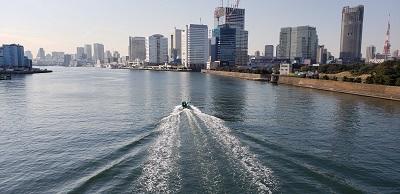
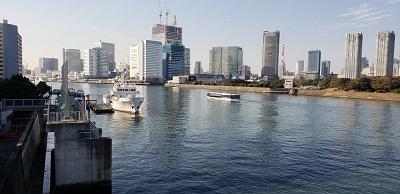
I just heard the whistle of the pleasure boat entering the departure and arrival point of Hamarikyu.
As you proceed along the Tsukiji Ohashi Bridge, you can see the departure and arrival point across the canal as if you were picked up.
You can do it. There is a fun conversation among many tourists who get off from here.
English, Chinese, and Cantonese are especially louder than Japanese, and the bustle of the departure and arrival areas.
It's even more gorgeous.
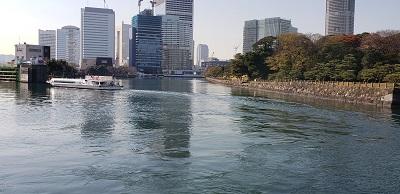
To get to Tsukiji Ohashi, get off at Kachidoki Station on the Toei Oedo Line and walk 10 minutes.
Toei buses go from the south exit of Marunouchi, Tokyo Station bound for Toyomi Fisheries Pier.
From Kameido Station to Tsukishima Station, bound for Toyomi Fisheries Pier
Both are a 5-minute walk from Niijima Bridge.
*It is also recommended to match the departure and arrival times of Hamarikyu on the Tokyo Cruise of Tokyo Kanko Kisen*.
Please note that is careful, and Hamarikyu is not seen from the sidewalk of the upper reaches.
[Hanes]
January 11, 2019 09:00
Hello. This is a new correspondent, Hanes. 
I think many people living in Tokyo bought souvenirs when they returned home at the end of the year.
I was one of them, and thought, "I want to buy New Year's souvenirs in Chuo-ku!"
I bought some souvenirs in Tsukiji, Ginza.
■"Hishi Hanabira,"
This is a product of Shiga Taneya, not Ginza, but it is a product of Shiga Taneya.
Shops that can be purchased nationwide are limited, and there are three locations in the center: Ginza Mitsukoshi store, Nihonbashi Mitsukoshi store, and Nihonbashi Takashimaya store.
When purchased at the Ginza Mitsukoshi store, the packaging says "Ginza Mitsukoshi store" and "Ginsan", which is said to have been purchased at Ginza (Chuo-ku).
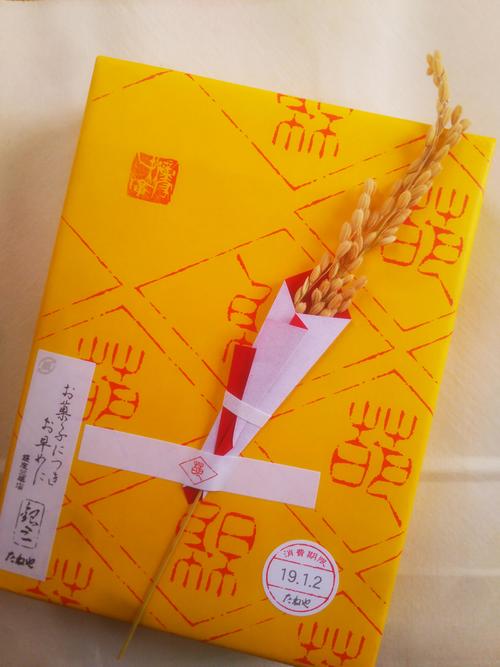
And on the inner hanging paper, it is written in seal engraving that "Is it as a noodle."
It is a sign of the Taneya Group with the meaning of "expressing using the words of the year ring and Laozi and expressing the continuation of the relationship", and it seems that it was written by calligraphers.
In addition to the packaging with rice ears, the paper is also auspicious and has a good appearance, so it is perfect for New Year's Day.
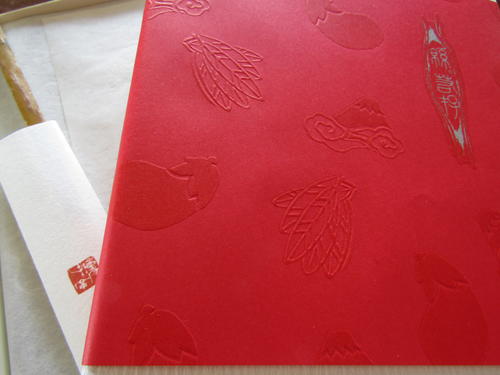
The most important thing is that it looks like this.
In addition, I also purchased "Yukiharu Enfuku Fukumi Tenpyo", but all were elegant and gorgeous, and were very satisfied Japanese sweets.
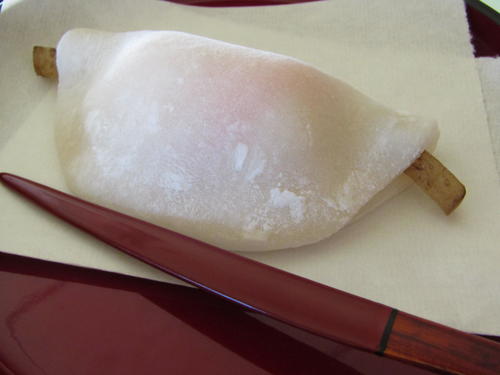
■Coffee (* This is not a souvenir that is conscious of the New Year.)
There are many coffee shops and coffee shops in Chuo-ku, but there are many coffee shops and coffee shops.
When it comes to coffee like Chuo-ku that can be mailed and lasted for a long time, isn't it easy to come up with something like this?
So, what I recommend is the No.1 "City Blend" drip bag of Tsukiji Yonemoto Coffee's unsellable savourable No.1 "City Blend" drip bag.
It has a deep and fragrant taste that cannot be reckoned even if it is a drip.
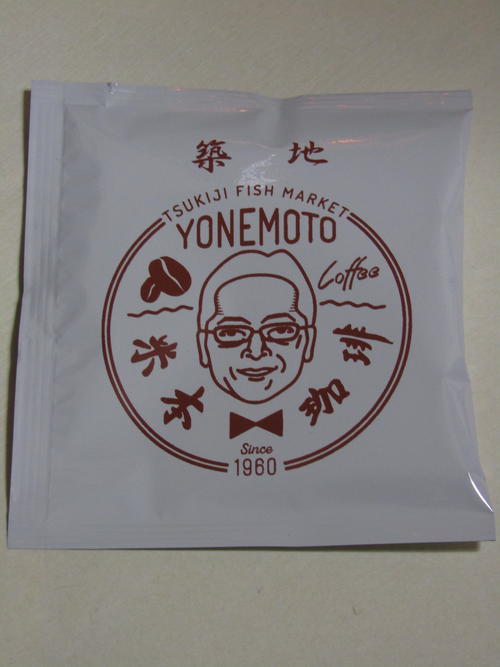
There are other coffee shops only in Chuo-ku where you can buy coffee beans, etc.
There are not many things on the package that you can see the uniqueness of Chuo-ku in Japanese and English.
How about souvenirs from Chuo-ku and gifts to acquaintances overseas?
In Chuo-ku, there are plenty of long-established products that can only be obtained here, store-limited products, and seasonal products.
It's easy to worry about choosing a souvenir, but you'll surely be happy to give it and you'll find a nice item to get it.
[Hanes]
January 10, 2019 14:00
Hello. This is a new correspondent, Hanes. 
Join us on a tour for correspondents (it is a privilege of correspondents who can tour places that are not usually open to the public)
The other day, I went to Tsukiji Outer Market with Mr. Kozaru, a senior correspondent who was getting along well.
One of the merits of becoming a correspondent is that you can also interact with those who are interested in the history, culture, gourmet, events, etc. of Chuo-ku.
If you are looking for a companion to walk around the town, or if you are looking for a pioneering partner for Ginza / Tsukiji gourmet, please
Why don't you take the Chuo-ku sightseeing test and aim to be a correspondent?
By the way, the new specialty of Tsukiji in the title is the grand opening on January 11th.
You can have it at TSUKIJI DELI Tsukiji alley back store produced by Tsukiji Oomiya Beef Store.
The place is on the left side of the narrow passage between Isemasa, a marine product, and Tsukiji Kimuraya, famous for Anpan.
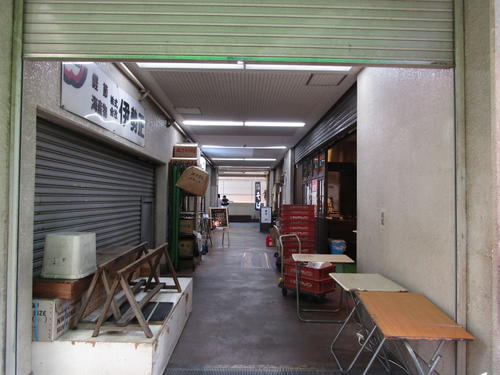
(It's around where you can see the signboard.)
The interior of the store has a brick motif that reminds you of Tsukiji during the Tsukiji Reservation period, and is stylish.
And because it is located behind the alley as you can see in the store name.
It's calm enough to think, "Is it really a Tsukiji Outer Market?", It looks like a hideaway.
Isn't it a perfect place when you want to relax a little in Tsukiji, where there are many people?
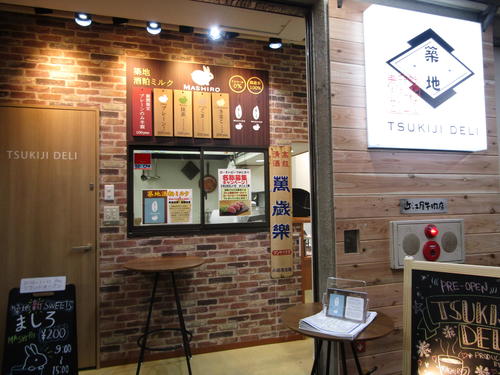
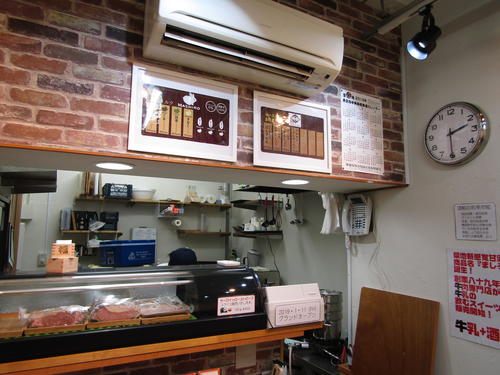
And the menu that is expected to become a new specialty is the menu.
Tsukiji sake lees Milk Mashiro (MASHIRO) and roast beef rice ball (RBO).
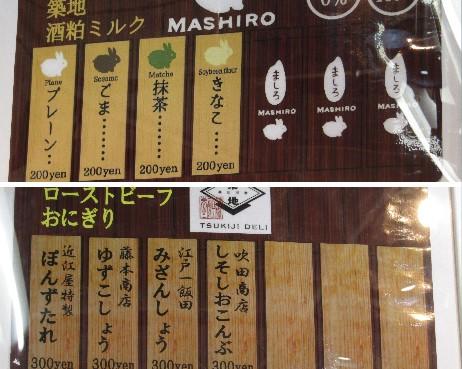
The visit was a pre-opening period before the grand opening.
We were able to get more (Plain) for half price of 100 yen!
The white rabbit (based on the legend of Kaga's Moon Rabbit) is very cute and seems to be a girl.
It's not just cute.
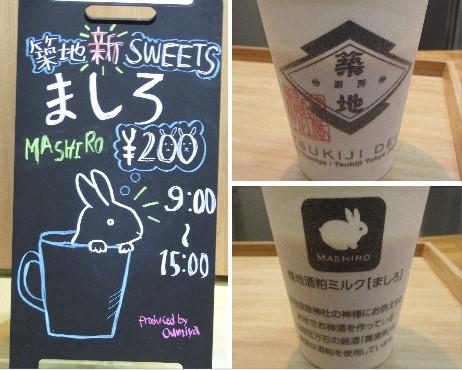
This drink was made of rice offered to the god of Tsukiji Namiki Shrine.
It is a blend of precious sake lees and milk from Kaga Hyakumangoku famous sake "Manzai Raku".
It is a drink close to the god who has been watching Tsukiji for a long time since the landfill and construction of Tsukiji.
It can be enjoyed by drivers, regardless of men and women of all ages.
Another point is that it is non-alcoholic.
The scent is very similar to the usual amazake, but I was surprised to drink it!
Certainly, you can see that sake lees are contained, but the richness of milk is as effective as sake lees, and it is very smooth.
It is a sweet that you drink with a new sense that you did not seem to have ever existed.
And sake lees have a lot of nice effects.
It is said that sesame, matcha, and kinako flavors are also recommended because each taste comes out.
Next time, I would like to have other flavors.
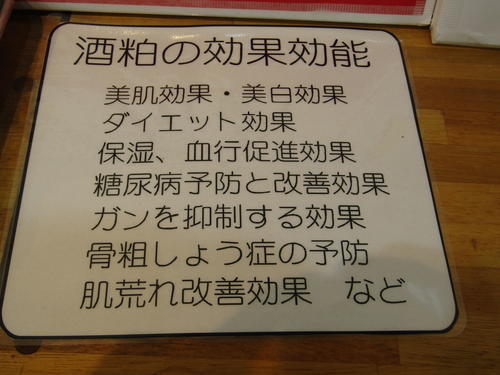
Also, the roast beef in the case seemed to be too delicious.
I also had roast beef rice balls!
This is a roast beef of serloin, which has been established for 90 years this year, with the reputation of Oomiya Beef Store.
This is a kind of collaboration product that incorporates ingredients from shops in Tsukiji Outer Market as ingredients.
It seems that there will be six types later, but the tools at the time of the visit were "Oomiya Special Ponzutare", "Fujimoto Shoten Yuzukosho", "Edo Ichi Iida Mizansho", and "Suita Shoten Shisoshi Okonbu".
All of them look delicious and get lost.
Meanwhile, we chose "Suita Shoten Shisoshi Okonbu" (Kozaru-san) and "Fujimoto Shoten Yuzu Kosho" (Hans).
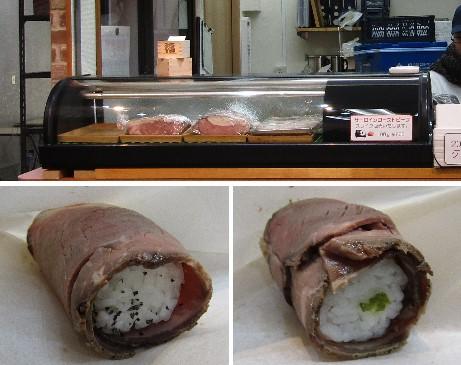
(Lower left: Shisoshio konbu, lower right: Yuzukosho)
The roast beef is very soft and I think, "Isn't it easier to bite than laver rice balls?"
Because it uses about 4g of roast beef, it has a volume.
I was thrilled that the rice ball part is rolled multiple times instead of one roast beef.
According to the shop, yuzu pepper is different from what you usually imagine, and it was fresh and a little bit crisp.
That's exactly right, the scent is very good, and I feel like "Yuzu pepper was so delicious ." ."
The solid taste and commitment of the store providing the ingredients were also shining.
Tsukiji is also famous as a tourist destination, but it is also a workplace.
The TSUKIJI DELI Tsukiji alley back store introduced this time excites the Tsukiji outside market with new products (new specialties).
It seems that people working in Tsukiji can also drop in casually and aim to make it a shop that can be used.
Of course, the word of mouth of tourists is also helpful, but it is those who work in the land who know hidden famous shops.
Even in Tsukiji, there are many shops that have become popular because they are said to be "Tsukiji professional purveyors" or "Tsukiji site related purveyors".
Therefore, it is also important to gain the support of those who work at Tsukiji.
This is currently called "Roast Beef Onigiri (RBO)", but we are actually looking for a name! (Deadline is February 28, 2019)
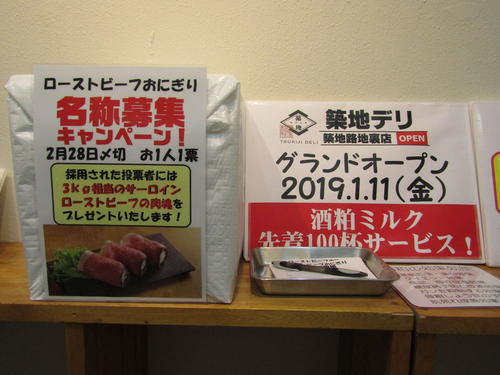
For those who have been hired, what! A meat chunk of sirloin roast beef equivalent to 3kg will be presented.
When you showed me how much it actually is, it seems to be this much.
Isn't it quite a lot?
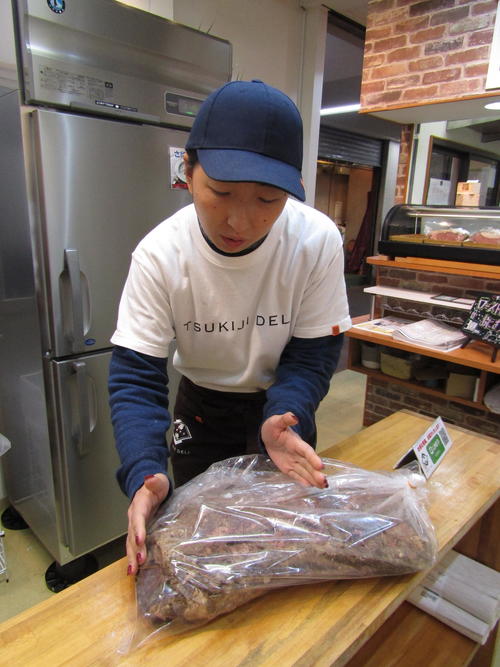
When you come to Tsukiji, please taste this rice ball and participate in the name recruitment campaign.
There's not a lot of such a luxurious and hungry campaign.
In addition, mackerel miso boiled (frozen), which was taken over by Chiaki third generation of fish riverbank, is also treated as a hidden specialty.
It's thick, has a strong taste and looks delicious.
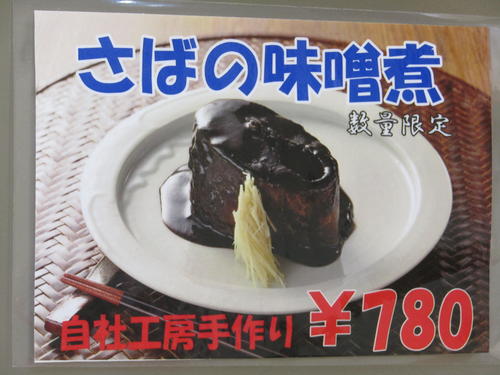
In addition, we also sell goods such as fashionable bags, T-shirts, and can badges with cute rabbits.
When you shop at Tsukiji, the number of plastic bags will increase, right?
In such a case, this bag is just right for putting your luggage together, and the town is well attached.
I'm glad that it can be used as a souvenir of Tsukiji and can be used everyday.
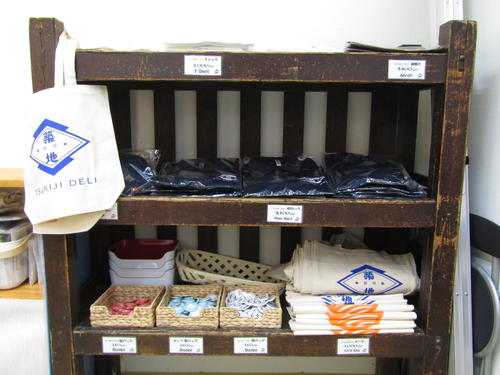
The shop is kind and comfortable, and I think it is a shop that will become more and more talked about in the future.
Why don't you go to taste the new specialties a little earlier?
■TSUKIJI DELI Tsukiji alley back store
Address: 4-14-1, Chuo-ku, Tokyo Monte Velde Tsukiji 109
(A little further along the narrow passage between Isemasa and Tsukiji Kimuraya)
Business hours 9:00~15:00
Regular holidays: Day, celebration
Take-out response: Allowed
Official Facebook: Here
Official LINE: Search for "TSUKIJI DELI alley back store"!
※We have received permission for introduction from the shop.
[Hanes]
January 1, 2019 09:00
Happy New Year
It's Hanes, a new correspondent!
Everyone, did you eat New Year's Eve soba at the end of the year? And did you go to new year worshipping on New Year's Day?
This time, we will introduce the traditions and culture of the Edo period related to the year-end and New Year holidays.
I would like to deliver a New Year's scenery in Chuo-ku.
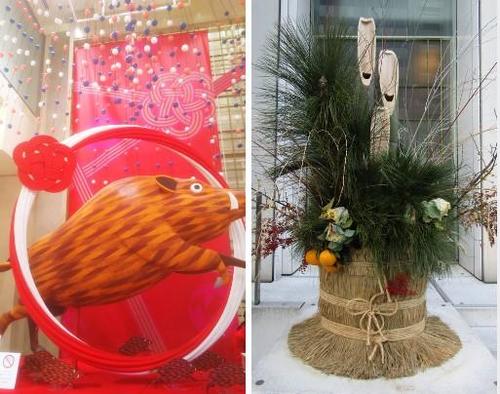
(Left: Ginza Mitsukoshi, right: Ginza Ukaitei)
■A story near the Edo period
It is now a soba that has become established as a food to eat at the end of the year.
Did you know that soba was actually popular in the Edo period?
It is said that night stalls called "Yataka Soba" flourished, and at its peak, nearly 4,000 soba shops lined up in Edo City!
At first, I was soaked in soba juice, but during the Genroku era (1688-1704), a way to eat juice was devised.
From this time, "Kake" (with hot juice) and "Mori" (with conventional juice) have been distinguished.
Since the Meiji era, "Zaru" (dispersed glue on "Mori") appeared.
And late Tokugawa shogunate came out of "Okame soba" (a few kinds of ingredients arranged on the side like a kame mask).
I'm worried about the differences between each soba shop lined up in Edo city.
■The story of the fish market in the Edo period
On the New Year's Day of the Edo period, it was customary to rest both the shopping street and the fish market.
It is said that the fish market clerks celebrated the adult day on New Year's Day, ate zoni, and spent sleeping.
However, some young people seemed to have gone to Eho-san (the prototype of new year worshipping) or to see the play.
At night, the Japanese lantern was hung without gaps so brightly that it was said to "blow the daytime."
We arranged seafood on a board boat and prepared for the first sale starting at 0 o'clock on the 2nd.
The first sale was so crowded that it was difficult to walk, but it seems that a lion dance called Ichibun lion that excites the mood sometimes entered.
Just listening to the story, it seems that the excitement of not pushing and pushing is floating in my mind.
■Kabuki
At Kabukiza, the first day will be celebrated on the 2nd.
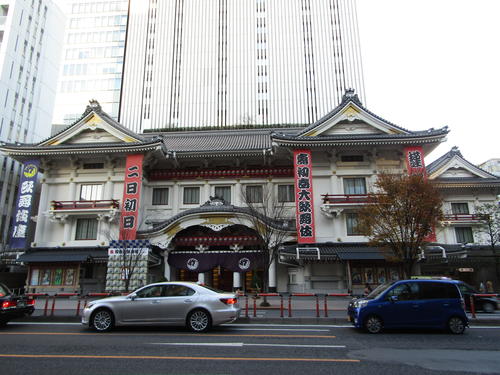
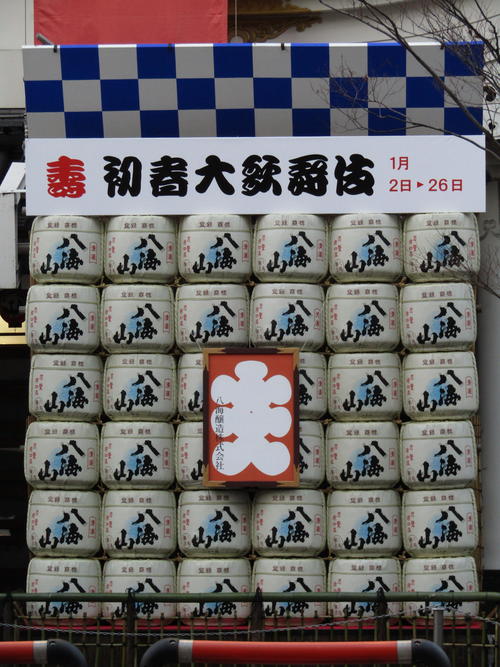
The birthplace of Edo Kabuki is also located in Chuo-ku.
It would be nice to try the traditional performing arts early in the New Year.
■<Aside> The story of a building in Chuo-ku in 2019
Chuo-ku, a construction rush, including Olympic athlete villages (later HARUMI FLAG) and numerous hotels and condominiums.
The environment for accepting foreign visitors to Japan will be enhanced, and the number of residents is expected to increase.
On the other hand, the preparation and construction of cultural facilities that are good for existing residents seems to be progressing one after another.
In July 2019, a high-rise building called Museum Tower Kyobashi (MUSEUM TOWER KYOBASHI) is scheduled to be completed on the site of the former Bridgestone Headquarters Building.
The Bridgestone Museum of Art later changed its name and entered the lower floors as the Artizon Museum (ARTIZON MUSEUM).
This will be a new base for cultural arts, and a lively atmosphere will be created in the (tentative name) Art Square, a plaza that will be maintained on the ground.
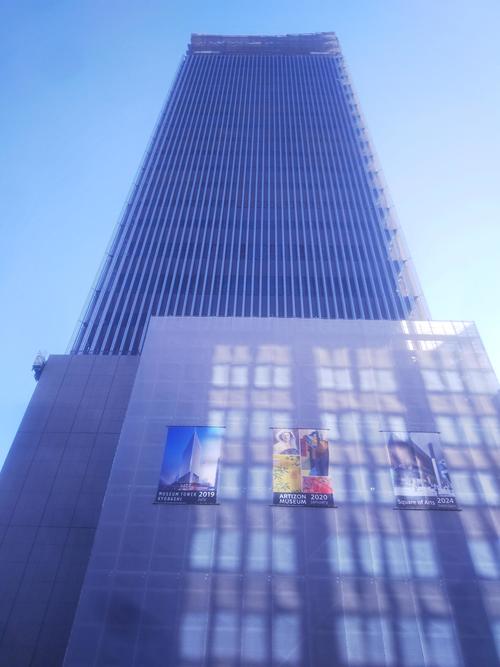
Also, in Shintomi, a complex facility such as a library (tentative name) Honnomori Chuou is scheduled to start construction in July 2019 (scheduled to open in 2022).
Please come and visit Chuo-ku, where the topic is constantly growing and every day this year.
Chuo City will never cease to amaze us :)
[Hanes]
October 28, 2018 18:00
Hello. This is a new correspondent, Hanes. 
On 20th of this month, I went to "Nihonbashi Ebisu Lecture Bettara City", which was introduced by senior correspondent Shiba Inu.
I was learning about Betara City in the official text of the Chuo-ku Tourism Certification, but
This is the first time I actually went to see it!
I read the news that a very large number of people were expected and went to the site a little earlier, and it was already crowded with many people because it was the second day of the event.
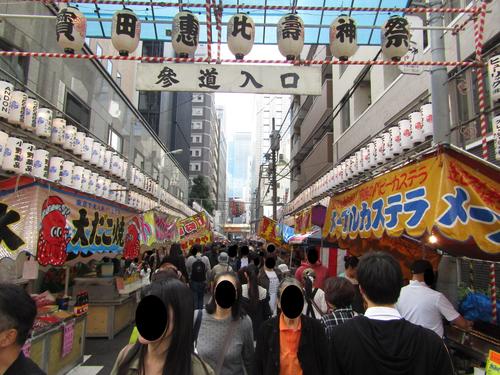
There are many stalls that are often seen at festivals.
The most crowded place was the stalls pickled in Betara.
In the first place, Betazuke is a shallow salted radish pickled on a rice koji floor.
It is a traditional food that has been eaten since the Edo period.
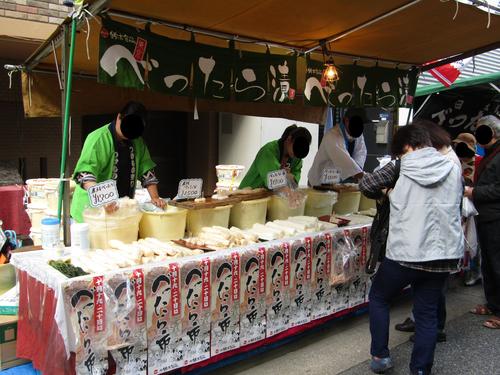
It seems that the fifteenth general Yoshinobu Tokugawa also liked to eat it.
When we think that we are talking about the same thing in modern times, it feels strange.
At the store, you can sample pickled vegetables, etc.
It's fun to go around multiple stores to find your favorite pickles.
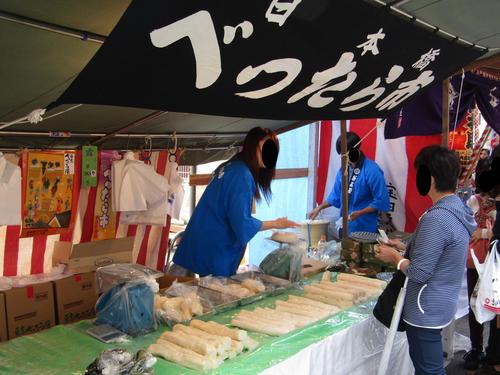
When I went around the shop while actually tasting, I was worried about two things.
The first is that no shop should cut the pickles and bag them.
Even though it is soft, it is difficult to bring one radish back as it is.
I was thinking, "I'm somewhat unfriendly ." ."
Actually, there was a great reason to give it without cutting it.
The reason for this is that "betara pickles are lucky items, so I don't cut them."
If you say that, it's a bit hard to bring it home, but I want you not to cut it!
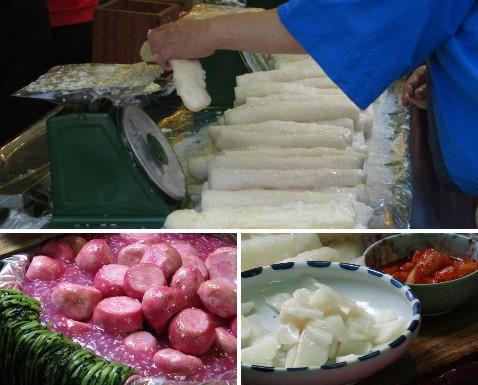
The second is that there are "skin" and "no skin" in Betta pickles.
It's literally the difference between whether the skin is attached or not.
The one with the skin is chewy and has a texture close to Sawaan.
According to the shop, it seems that people without skin have been around since the Edo period.
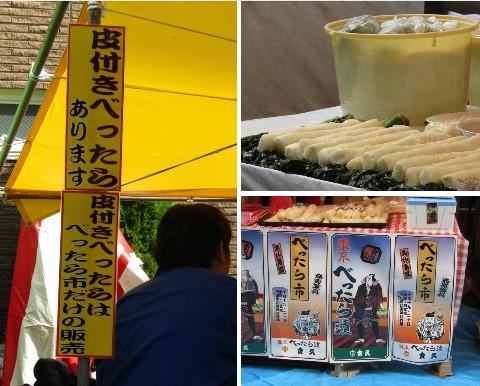
And there is also a Yu-Pack service that is good for those who buy Betara pickles for adults and those who come from a distance by train!
Why don't you use it when purchasing a lot?
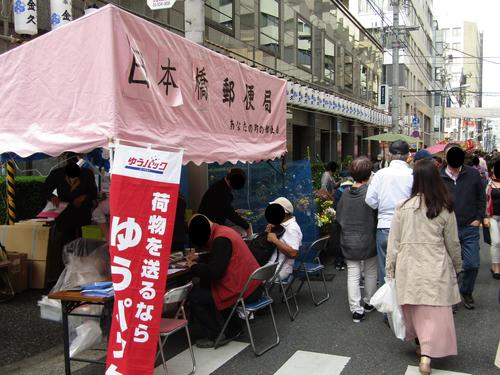
In the Edo period, there was a custom in which Ebisu-ko was held in front of Takarada Ebisu Shrine Gate on October 20. At an event dedicated to Ebisu, the god of commerce and agriculture, he offered lucky items to pray for thriving business.
Today, vermilion seal stamp can be held only during the New Year's Day and Betara City, so many people gather at the shrine and enjoy the atmosphere of the place while thinking, "Is it so crowded at that time?"
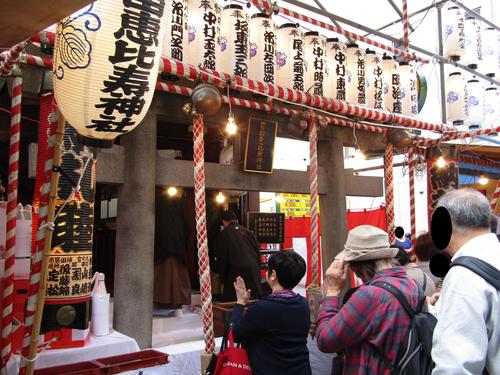
Also, if you jump out of the venue of Bettara City and walk around the town of Nihonbashi, you will find it.
The "He" of "Nippon Nihonbashi Karuta" depicted in the enclosure of the construction being carried out at the site of the Nittetsu Nihonbashi Building.
I realized that it was about Betara City!
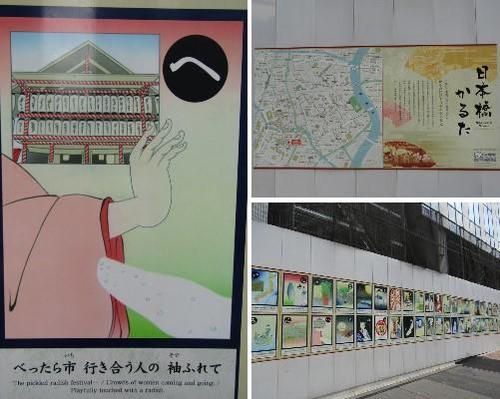
Let's touch the sleeves of people who go to the city.
Because I carried it with just tying the radish with a rope, I carried it around.
It is a content that reminds me of the origin of Betazuke, which has come to be called "Betazuke" because it inadvertently scratched the clothes of other people.
For women who pass through pickle so that they don't want to keep their kimono dirty.
During the Edo period, when there was a man who was interesting and tried to put on the ground on purpose....
In today's Betara city (unfortunately?) There is no such man, but
If you missed your chance this year, why not come and play next year?
[Hanes]
October 25, 2018 09:00
Hello. This is a new correspondent, Hanes. 
When I went to Nihonbashi Ebisu-ko Betara City, I stopped by a long-established Edo-ya, founded in 1718, which was particularly crowded.
As written on the wall of the building, this shop deals with brushes, etc.
It is this unique appearance that catches your eye before entering the store!
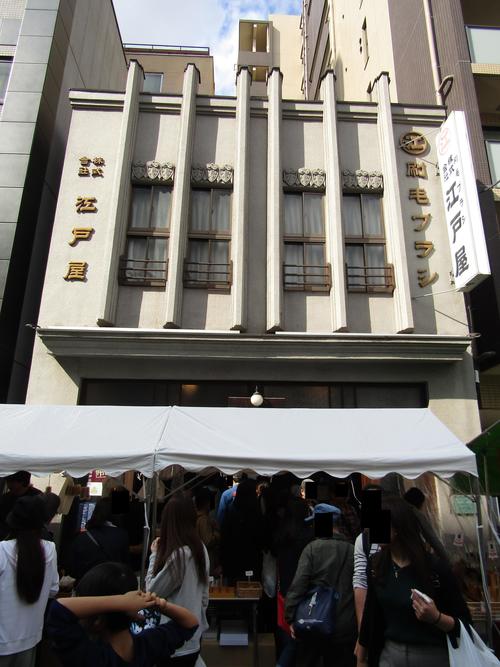
This expresses a brush, and it is an architecture that uses the technique of artificial stone washing finish.
If you say that, it's certainly like a brush.
It is a valuable building registered in the country-registered Tangible Cultural Property.
It is also published in the official text of the Chuo-ku Tourism Certification.
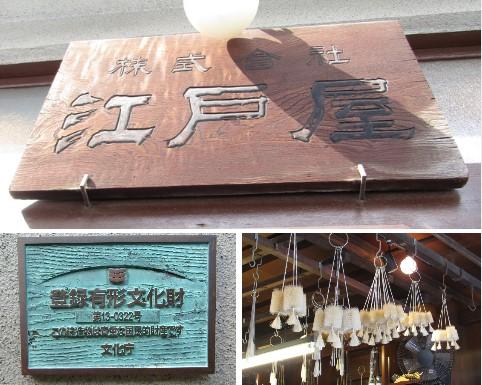
A lot of brushes and brushes are hung from the ceiling inside the store.
From there, I got a glimpse of traditional techniques that could not be imitated with modern convenient techniques.
In addition, the warmth and taste unique to wooden architecture (built in 1924) is impressive.
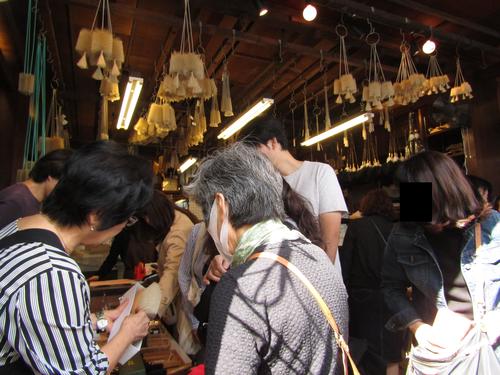
In addition to brushes, toothbrushes and hairbrushes for clothes, shoes, cleaning, makeup, etc.
There are a wide variety of products, including brushes for Japanese calligraphy and brushes for painting.
Isn't it just right as a gift or a souvenir of Chuo-ku ? ?
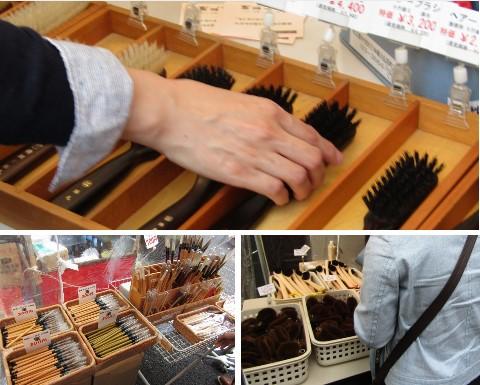
I purchased this toothbrush for my family, which was profitable during the period of Betara City.
The brush part has horse hair (softened, normal), pig hair (flat), normal size and large size.
It's different from familiar transparent and white brushes, and it's hard to see elsewhere.
Would you like to try out what kind of polishing it feels like?
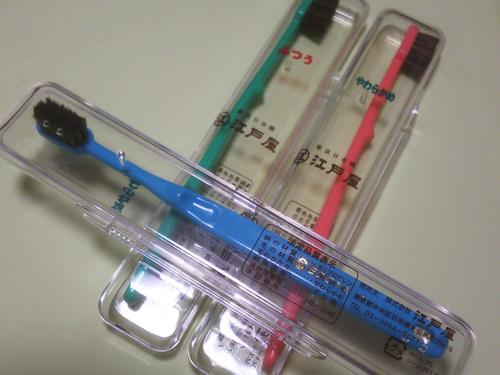
According to the shop, the hair gradually becomes shorter while using it, but it seems that the hair gradually becomes shorter.
It seems that it lasts 3-4 months, long and half a year!
Also, "softening" can be used for gum massage.
This shop, which began with the first Ribei, who became a brush master of the Shogun's family in the era of the seventh shogun's family, has been in business for 300 years this year!
This wonderful tradition and technology is a treasure that we want to pass on to the future.
■Edoya
Address: 2-16, Nihonbashiodenmacho, Chuo-ku, Tokyo
Business hours From 9:00 to 17:00
Regular holidays: Saturdays, Sundays, and holidays
Website: http://www.nihonbashi-edoya.co.jp/
※This article has been approved by the person in charge of Edoya.
|
Links
|




































